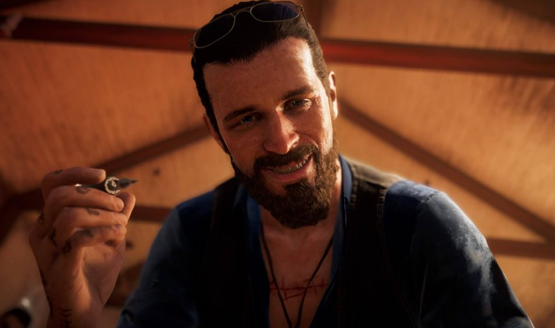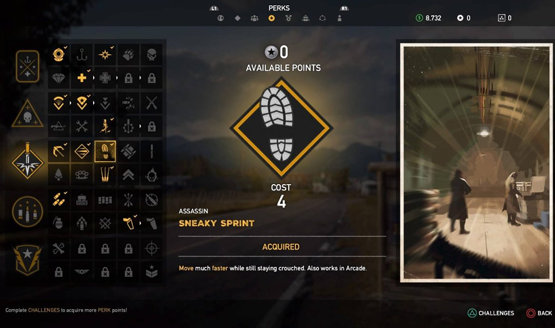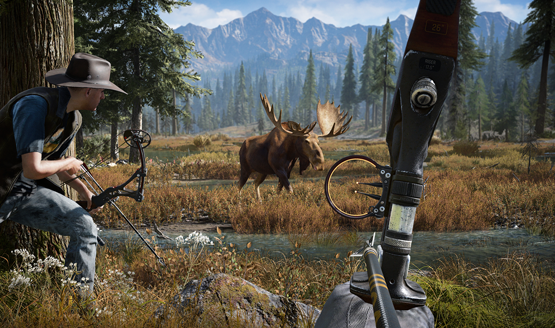The Far Cry series has always been about flinging players into remote places cut off from the rest of the world, tasking them with survival against the elements and psychologically terrifying villains. Far Cry 5 brings the series home to America, dropping players into the isolated Hope County, Montana. A doomsday cult lashed under the silver tongue of The Father, Joseph Seed, has the county in an iron grip. As a rookie deputy on a small task force sent to arrest Seed, I’ve never felt closer to home while simultaneously feeling more cut off and far away than ever before.
Far Cry 5’s world building is phenomenal. I genuinely felt like I was in remote and rural America that was violently deadlocked between a psychopathic doomsday cult and the residents of the valley that just want to get on with their lives. Each location tells a new story of the people and their conflict. Every corner of Hope County feels unique and there was a pervasive sense of life to exploration.
It was a risky bet to pull Far Cry into America, but Ubisoft manages to maintain a fair depiction of rural life without forcing sides and creating controversy. Seed and his cult are not politically motivated. The Father’s machinations are religiously motivated, based on the idea of an impending apocalyptic event he calls “the collapse.” Never does Far Cry 5 take an ingrained political approach with the Eden’s Gate story. There are jabs in side missions here and there, lobbed at both party lines, however the crux of the main conflict never lampoons into cheap shots or a petty political agenda.
Far Cry 5’s opening sequence is a dark look that cements Seed’s place as an exceptional villain. He’s calm, collected, and his followers will literally throw themselves into helicopter blades to prevent him from being taken from them. Each of his siblings play admirable roles without ever feeling like they are simply getting in the way of a better antagonist. The three lieutenants–Faith, Jacob, and John–have deep and unique personalities, each driven by their own motivations and backstories. The best villains fight because they feel their cause is just. Seed and his followers believe in their cause to a fault. They are the heroes of their own story. Sincerity permeates the Eden’s Gate leadership, and to believe so strongly makes each one of them even more frightening to face off against.
State of Bliss
And then there’s the bliss. Bliss is the MacGuffin drug that somehow conveniently works for whatever plot point or gameplay mechanic that Far Cry 5 needs it to. There are no defined rules, and by the end I found myself frustrated that so much of The Father’s success hinged upon dispersal and use of a mind numbing, mind altering, and at times, mind controlling drug. I wanted to fear Joseph Seed because of his charismatic and persuasive nature, not because of this MacGuffin drug. One moment near the conclusion leaned heavily on the bliss as a crutch, contrasting a really interesting section of gameplay with a question on why or how it could even be happening that way. The substance really undercut each of the antagonists, except perhaps Faith, whose arc is tied to giving in to the bliss.
Far Cry 3 and 4 both had charismatic yet terrifying villains, cunningly psychotic men that bordered on being caricatures. Their dark natures nearly crossed into parody, and some of Far Cry’s goofier aspects fit well within those games due to main antagonists already treading so close to that line. Far Cry 5 finds itself with a much wider divide. Joseph Seed is far more damnable than either Vaas or Pagan Min. His tone is more ominous, and thus more serious, which makes Far Cry 5’s kooky side missions, characters, and weapons feel imbalanced at best, and completely out of place at their worst. Contrasting things like the Testicle Festival side mission and obtaining an alien vaporizer weapon with Seed delivering a monologue about how he murdered his own infant daughter because God told him to puts a strange burden on the player. Suspension of disbelief is hard to maintain when the disparity is so vast. Either the serious themes get lost or the jokes feel insensitive to the situation.
Imbalance between the serious and lighter moments comes as a result of Far Cry 5’s non-linear approach to both gameplay and storytelling. Players can participate in any activity they want to in any of the three regions around Hope County. Each region is held by one of The Father’s lieutenants, and completing events, missions, and various activities will raise a resistance meter. At certain intervals, a new story scene or mission will play out, progressing until the meter is full and the region is considered completed. After all three have been finished, the final confrontation against The Father can begin.
With this approach, the world feels distinctly divided into three smaller games. Each region is self-contained. None of the characters or events cross borders (the most you’ll find is collectibles scattered among all three). The characters don’t acknowledge your conduct in other regions. Progression feels stunted because my actions don’t feel like they have a meaningful and dynamic impact on the world. Characters that were supposed to be important to me often didn’t resonate as I undertook tasks in any order I wanted. In one case, I didn’t even meet one particular character before they became part of a main story plot, leaving me more confused than I should have been. I understand wanting to offer the player freedom, but many games (including previous Far Crys) have accomplished a fair balance of freedom and solid narrative structure.
Anything Can Happen in Hope County
I can’t say that I didn’t have a lot of fun exploring the world of Far Cry 5 at my leisure though. The world is made to feel organic, with discovery happening through talking to people, picking up maps, or just happening upon things while taking an ATV through a thick forest. Narrative problems of non-linear progression aside, it does allow for the world to feel more welcome in exploration. Anything can happen in the world. Planes crash into the forest. Camping couples dance to a guitar ballad. Bears can attack the guy handing you information. Stumbling across a mission that gave me a microwave gun to vaporize my enemies was an exciting surprise instead of an expected target. Non-linearity provides the opportunity for surprises like these. Gameplay progression however, suffers, particularly in comparison to previous Far Cry titles.
The world was always tied to progression in previous Far Cry games. If you wanted a bigger quiver, you had to get pelts to craft it. Certain side missions tied into abilities and upgrades. The perks were a progressive tree. Far Cry 5’s freedom bleeds over to to progression, to the detriment of meaningful character advancement. Everything is unlocked via perk points, which can be farmed through prepper stashes or even outside of the main campaign in Far Cry Arcade. You could nearly end up with a full set of perks without touching a single mission or activity in the main game. Hunting, fishing, and other side activities have very little purpose anymore except to pull in some additional cash (which also serves very little purpose in gaining any kind of growth or advantage).
The saving grace here is the guns-for-hire characters that can accompany the player and have special abilities for taking on cultists. Bringing Boomer the dog along will mark enemies in the area automatically for you. Jess can hit a target with her bow at an impressive distance. Hurk Jr. brings explosives to the party with his rocket launcher and a handful of one liners. There are nine in total (three per region), each worth picking up from their respective side mission. These are the only meaningful pieces of gameplay progression tied to the world activities though. While Far Cry 5 touts its ability to let players leisurely take on the world, those activities are shallow and meaningless in terms of improving the silent player character. It’s a huge step backwards from how the series has handled side activities and advancement in the past.
From an immersion perspective, the silent protagonist is intended to allow the player to more fully step into the shoes of the rookie deputy and become the character. Ubisoft didn’t want to make the main character say anything that the player might disagree with, but what if we disagree with a silent complacency? Even if I disagree with a character’s responses and actions, I can at least have a better connection with them if they have any kind of personality. Instead, the rookie is a grey blob without an emotional reaction or a word to say. I was nothing more than an observer to the events, and an errand boy shaking up the conflict between a mad cult and those who want to fight back. Previous Far Cry games have made me feel a part of events through the player character, but Far Cry 5 positioned me as a nobody on the back end of a gun. I had no real motivation or reason to be there because I had no actual identity. There’s a very deep alternative message that players can possibly derive from that (think the BioShock twist ending), but it’s never cleanly stated.
Killing Cultists, Making Friends
Far Cry 5’s entire campaign is playable in co-op in a system called “friends-for-hire.” Your friend essentially replaces one of your two guns-for-hire slots and can help with anything in Hope County. Money and perk points earned while in another player’s game will be saved to your character, however only the host’s world and story progression will save. Don’t expect to make progress liberating regions if you are joining your friend’s game. You can always invite them to your version of Hope County instead.
In addition to the cooperative campaign, Far Cry Arcade can be played in both co-op and competitive multiplayer (as well as solo for designated solo/co-op maps). While play, create, share isn’t the first thing that comes to mind when I think of Far Cry, Far Cry Arcade has an impressively intricate map editor that allows players to create their own maps, both for PVE challenges and PVP competitive matches. The early review period doesn’t yet have anything noteworthy, but I did play through some cool concepts that showcased a number of different moving parts that can be controlled by the creator. This mode will be entirely dependent on the community to drive success, but Ubisoft has provided a brilliant platform to get them started.
Far Cry 5 takes steps forward by upping the stakes with a sinister villain and bold new setting, while also stumbling backwards with its non-linear approach and separation of character progression from the world. A silent protagonist and convenient MacGuffin undermine the imposing nature of The Father and Eden’s Gate, though I still think Joseph Seed is the best Far Cry villain yet. Clear effort went into making sure Far Cry in America would work, as well as giving the player a lot of freedom. Those pieces came at the expense of meaningful progression and solid narrative structure to fully support the ominous cast. It handles the balance between goofy and serious clumsily, leaving me not quite sure which it wants to be more. For both better and worse, Far Cry 5 is a far cry from those that came before, though it’s still a lot of fun to play.
Far Cry 5 review code provided by the publisher. Version 1.03 reviewed on a standard PS4. For more information on scoring, please read our Review Policy.
-
Joseph, Jacob, John, and Faith
-
World building in Hope County
-
The underlying meta message
-
That great Far Cry gameplay
-
Endless possibilities in Far Cry Arcade
-
The bliss used as MacGuffin
-
Silent protagonist
-
Lack of meaningful gameplay progression
-
Each region feels like its own separate game











